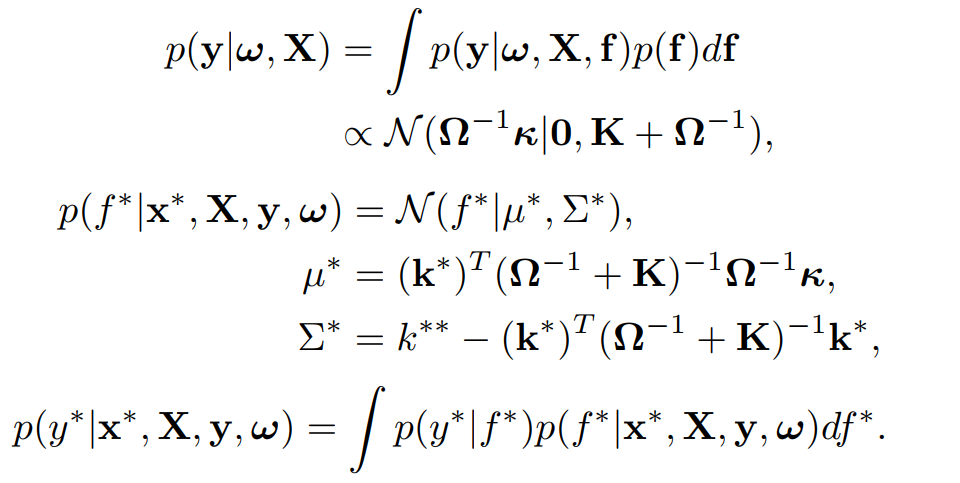论文笔记(9)-"Personalized Federated Learning with Gaussian Processes"
Personalized Federated Learning with Gaussian Processes
这篇blog不会涉及任何实现细节(因为我没看懂),也不会讲任何该方法的advantages(因为我也没看懂他到底怎么novel),只会说一说这篇文章干了什么事,总之会是一个很朦胧的blog(就装自己懂了吧)。
Motivation
这篇文章它自己提的motivation是“learn effectively across clients even though each client has unique data that is often limited in size”,大致意思就是如何在少量样本下建立一个PFL。然后作者就想到高斯过程(GP)在少样本条件下表现的很好,就想把GP搬到FL里。
Challenges & solutions
non-Gaussian in classification problem
因为FL很多都是分类问题,而在该类问题上得到的marginal distribution不是高斯分布。作者就提出引入服从Pólya-Gamma augmentation分布的变量

其中

似然可以写成这样形式:

后验是这样的:

Multiclass classification
上面这种Pólya-Gamma augmentation仅适用于二分类的情况,对于Cifar10,Cifar100这种多分类的问题,是不适用的。但是多分类问题可以划分为多个二分类问题,因此作者提出构建一个GP-tree,例如对于Cifar10数据这个GP-tree中应该有10个叶子节点,每一个叶子节点对应一个图片类别。树种的所有非叶子节点都对应一个Pólya-Gamma augmentation的GP。
在文中,作者是通过Kmeans或者Hierarchy cluster来构建树的,具体可以看下代码:
class Split(object):
# split the node into two or more branches
# the base class
def __init__(self, labels, branches=3):
self.old_to_new = {}
self.labels = labels
self.classes = np.unique(labels)
self.num_classes = self.classes.shape[0]
self.branches = branches
def split(self, *args, **kwargs):
if self.num_classes == 3:
self.old_to_new[self.classes[0]] = 0
self.old_to_new[self.classes[1]] = 1
self.old_to_new[self.classes[2]] = 2
elif self.num_classes == 2:
self.old_to_new[self.classes[0]] = 0
self.old_to_new[self.classes[1]] = 1
else:
self.old_to_new[self.classes[0]] = 0
return self.old_to_new
class ProtoTypeSplit(Split):
"""
split labels associated with a node to x branches by the prototype of each class.
close classes should be grouped together
:param labels: numpy array of the labels
:param branches: the number of branches
:param prototype: dictionary of {label: np.array()}
:param affinity: Metric - “euclidean”, “l1”, “l2”, “manhattan”, “cosine”
:param linkage: Distance to use between sets of observation: “ward”, “complete”, “average”, “single”
:return the original classes partitioned to nodes
"""
def __init__(self, labels, branches, prototype, affinity='cosine', linkage='complete'):
super().__init__(labels, branches)
self.affinity = affinity
self.linkage = linkage
self.prototype = prototype
def split(self):
# hierarchical clustreing
n_clusters = self.branches
clustering = AgglomerativeClustering(n_clusters=n_clusters, affinity=self.affinity, linkage=self.linkage)
lbl_assignment = clustering.fit(list(self.prototype.values())).labels_
for o, n in zip(self.prototype.keys(), lbl_assignment):
self.old_to_new.update({o: n.item()})
return self.old_to_new
class MeanSplitAgglomerative(Split):
"""
split labels associated with a node to x branches by the mean vector of each class.
close classes should be grouped together
:param labels: numpy array of the labels
:param branches: the number of branches
:param data: numpy array of the data
:param affinity: Metric - “euclidean”, “l1”, “l2”, “manhattan”, “cosine”
:param linkage: Distance to use between sets of observation: “ward”, “complete”, “average”, “single”
:return the original classes partitioned to nodes
"""
def __init__(self, labels, branches, data, affinity='euclidean', linkage='ward'):
super().__init__(labels, branches)
self.affinity = affinity
self.linkage = linkage
self.data = data
def split(self):
# mean vector of each class
means = np.array([0])
for idx, i in enumerate(self.classes):
tmp = self.data[np.where(self.labels == i)]
mean_vec = np.mean(tmp, axis=0, keepdims=True)
means = mean_vec if idx == 0 else np.concatenate((means, mean_vec), axis=0)
# hierarchical clustreing
n_clusters = self.branches
clustering = AgglomerativeClustering(n_clusters=n_clusters, affinity=self.affinity, linkage=self.linkage)
lbl_assignment = clustering.fit(means).labels_
for o, n in zip(self.classes, lbl_assignment):
self.old_to_new.update({o.item(): n.item()})
return self.old_to_new
class BinaryTreepFedGPIPData(BinaryTree):
def __init__(self, args, device):
super(BinaryTreepFedGPIPData, self).__init__(args, device)
self.root = NodepFedGPIPData()
self.root.id = 0
self.root.depth = 0
def build_tree(self, root, X, Y, X_bar):
"""
Build binary tree with GP attached to each node
"""
# root
q = deque()
# push source vertex into the queue
q.append((root, X, Y))
curr_id = 1
gp_counter = 0 # for getting avg. loss over the whole tree
# loop till queue is empty
while q:
# pop front node from queue
root, root_X, root_Y = q.popleft()
node_classes, _ = torch.sort(torch.unique(root_Y))
num_classes = node_classes.size(0)
# Xbar's of current node
X_bar_root = X_bar[node_classes, ...]
# two classes or less - no heuristic for splitting
split_method = 'MeanSplitKmeans' if num_classes > 2 else 'Split'
root_old_to_new = \
self.split_func(detach_to_numpy(root_X),
detach_to_numpy(root_Y))[split_method].split()
root.set_data(root_Y, root_old_to_new)
# build label vector of current node
num_Xbars = X_bar_root.shape[1]
i = 0
for original_lbl, node_lbl in root_old_to_new.items():
Y_bar_class = torch.zeros(num_Xbars, device=Y.device, dtype=Y.dtype) if node_lbl == 0 \
else torch.ones(num_Xbars, device=Y.device, dtype=Y.dtype)
Y_bar_root = Y_bar_class if i == 0 else torch.cat((Y_bar_root, Y_bar_class))
i += 1
# leaf node
if num_classes == 1:
# logging.info('Reached a leaf node. Node index: ' + str(root.id) + ' ')
continue
# Internal node
else:
gp_counter += 1
root.set_model(self.args.kernel_function,
self.args.num_gibbs_steps_train, self.args.num_gibbs_draws_train,
self.args.num_gibbs_steps_test, self.args.num_gibbs_draws_test,
self.args.outputscale_increase, self.args.outputscale,
self.args.lengthscale, Y_bar_root, self.args.balance_classes)
left_X, left_Y = pytorch_take(root_X, root_Y, root.new_to_old[0])
right_X, right_Y = pytorch_take(root_X, root_Y, root.new_to_old[1])
child_X = [left_X, right_X]
child_Y = [left_Y, right_Y]
branches = 2
for i in range(branches):
child = NodepFedGPIPData()
child.id = curr_id
curr_id += 1
child.depth = root.depth + 1
root.set_child(child, i)
q.append((child, child_X[i], child_Y[i]))
return gp_counter
那么对于类别

其中

Kernel function
对于一些图片、声音等数据,作者通过DL embedding出一个向量来作为文中的RBF kernel或者Linear kernel等核函数的输入。用户
Limitied data size
文中是通过广播一组common的数据集来帮助数据量比较小的用户来构建模型的(具体怎么操作看不懂)。
Computational constraint
因为GP里面要求逆,通常是样本数量
Summary
厚着脸皮来写个summary吧,
- 作者说要为数据量不足的用户也构建个性化模型,然后就想到了在少样本情况下表现也不错的GP。按作者的话,整个系统学的是一个kernel function前的DL网络,这个网络是所有用户共享的。
- 作者解决limited data size和compuitational constraint的方法都是通过一个common dataset(文中叫做inducing points),然后把其当作trainning set。怎么说呢,给我的感觉并不是从方法上进行了创新。整个文章的逻辑像是这个样子:GP在样本少的时候表现很好
- 总而言之,作者还是提出了一种PFL的方法。(代码没看懂,各种概率看着也头大,反正我是不会用的)



【推荐】国内首个AI IDE,深度理解中文开发场景,立即下载体验Trae
【推荐】编程新体验,更懂你的AI,立即体验豆包MarsCode编程助手
【推荐】抖音旗下AI助手豆包,你的智能百科全书,全免费不限次数
【推荐】轻量又高性能的 SSH 工具 IShell:AI 加持,快人一步
· AI与.NET技术实操系列(二):开始使用ML.NET
· 记一次.NET内存居高不下排查解决与启示
· 探究高空视频全景AR技术的实现原理
· 理解Rust引用及其生命周期标识(上)
· 浏览器原生「磁吸」效果!Anchor Positioning 锚点定位神器解析
· DeepSeek 开源周回顾「GitHub 热点速览」
· 物流快递公司核心技术能力-地址解析分单基础技术分享
· .NET 10首个预览版发布:重大改进与新特性概览!
· AI与.NET技术实操系列(二):开始使用ML.NET
· .NET10 - 预览版1新功能体验(一)